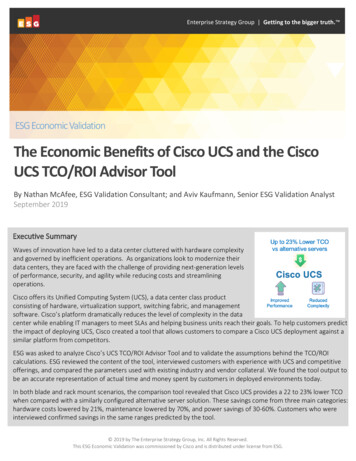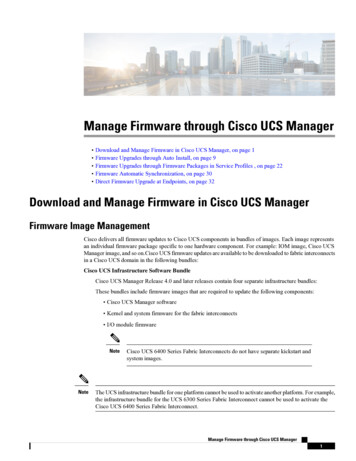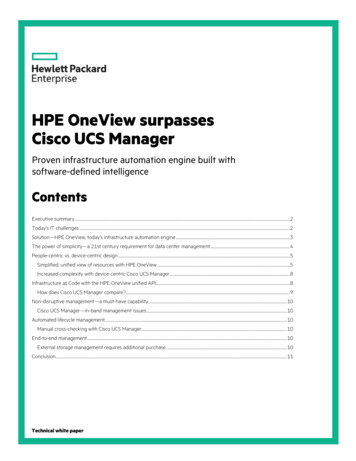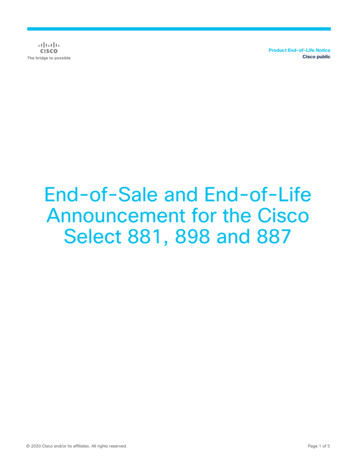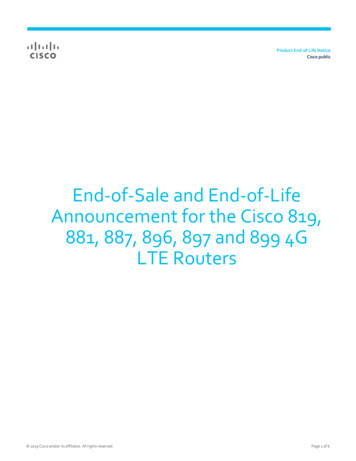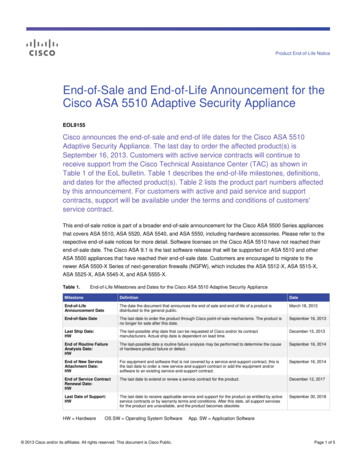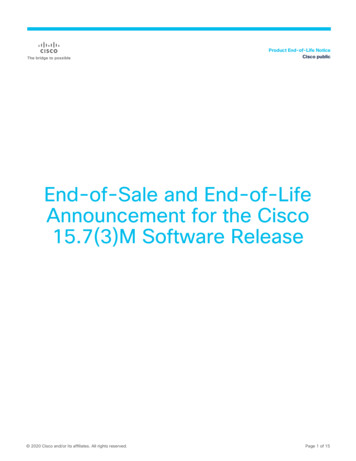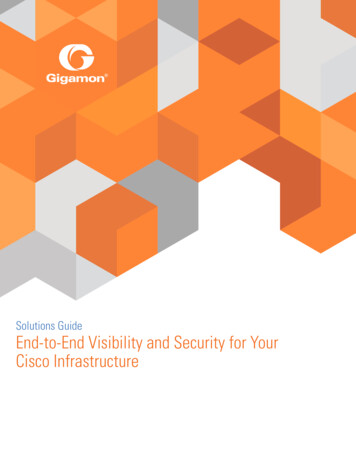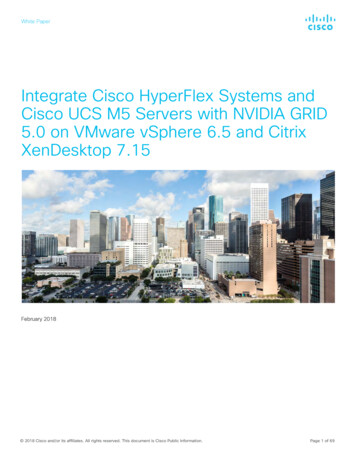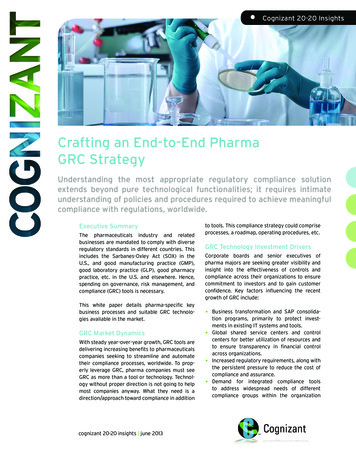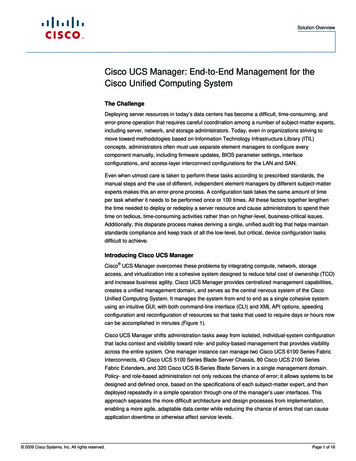
Transcription
Solution OverviewCisco UCS Manager: End-to-End Management for theCisco Unified Computing SystemThe ChallengeDeploying server resources in today’s data centers has become a difficult, time-consuming, anderror-prone operation that requires careful coordination among a number of subject-matter experts,including server, network, and storage administrators. Today, even in organizations striving tomove toward methodologies based on Information Technology Infrastructure Library (ITIL)concepts, administrators often must use separate element managers to configure everycomponent manually, including firmware updates, BIOS parameter settings, interfaceconfigurations, and access-layer interconnect configurations for the LAN and SAN.Even when utmost care is taken to perform these tasks according to prescribed standards, themanual steps and the use of different, independent element managers by different subject-matterexperts makes this an error-prone process. A configuration task takes the same amount of timeper task whether it needs to be performed once or 100 times. All these factors together lengthenthe time needed to deploy or redeploy a server resource and cause administrators to spend theirtime on tedious, time-consuming activities rather than on higher-level, business-critical issues.Additionally, this disparate process makes deriving a single, unified audit log that helps maintainstandards compliance and keep track of all the low-level, but critical, device configuration tasksdifficult to achieve.Introducing Cisco UCS Manager Cisco UCS Manager overcomes these problems by integrating compute, network, storageaccess, and virtualization into a cohesive system designed to reduce total cost of ownership (TCO)and increase business agility. Cisco UCS Manager provides centralized management capabilities,creates a unified management domain, and serves as the central nervous system of the CiscoUnified Computing System. It manages the system from end to end as a single cohesive systemusing an intuitive GUI, with both command-line interface (CLI) and XML API options, speedingconfiguration and reconfiguration of resources so that tasks that used to require days or hours nowcan be accomplished in minutes (Figure 1).Cisco UCS Manager shifts administration tasks away from isolated, individual-system configurationthat lacks context and visibility toward role- and policy-based management that provides visibilityacross the entire system. One manager instance can manage two Cisco UCS 6100 Series FabricInterconnects, 40 Cisco UCS 5100 Series Blade Server Chassis, 80 Cisco UCS 2100 SeriesFabric Extenders, and 320 Cisco UCS B-Series Blade Servers in a single management domain.Policy- and role-based administration not only reduces the chance of error; it allows systems to bedesigned and defined once, based on the specifications of each subject-matter expert, and thendeployed repeatedly in a simple operation through one of the manager’s user interfaces. Thisapproach separates the more difficult architecture and design processes from implementation,enabling a more agile, adaptable data center while reducing the chance of errors that can causeapplication downtime or otherwise affect service levels. 2009 Cisco Systems, Inc. All rights reserved.Page 1 of 16
Solution OverviewFigure 1.Cisco UCS Manager Provides an Intuitive GUI That Supports End-to-End System ManagementThe manager’s role-based design supports existing best practices, allowing server, network, andstorage administrators to contribute their specific subject-matter expertise to a system design. Anyadministrator’s role can be limited to a subset of the system’s resources using organizations andlocales, so that a Cisco Unified Computing System can be partitioned and shared amongorganizations using a multiple-tenant model.Every server that is provisioned in the Cisco Unified Computing System is specified by a serviceprofile. A service profile is a software definition of a server and its LAN and SAN networkconnectivity. Service profiles allow server resources to be treated as raw computing capacity thatcan be allocated and reallocated among application workloads, enabling a much more dynamicand efficient use of server capacity regardless of whether server virtualization is being used.Server deployment using service profiles takes minutes instead of days or weeks. Service profiles are created by server, network, and storage administrators and are storedin the Cisco UCS 6100 Series Fabric Interconnects. When a service profile is deployed ona server in the spare computing pool, the manager automatically configures the server, itsnetwork adapters, fabric extenders, and fabric interconnects to support the configurationspecified in the service profile. This automatic device configuration reduces the number ofmanual steps required to configure servers, network interface cards (NICs), host busadapters (HBAs), and LAN and SAN switches. The reduction in manual steps helps reducehuman error, improves consistency, and reduces server deployment time. A service profiledescribes how all low-level firmware and device settings in the computing system need tobe configured, including the RAID level of internal disk drives on the server, BIOS settingssuch as boot order, firmware revision levels for the BIOS and network adapters, NIC andHBA identities and settings, network settings for VLAN and VSAN membership andbandwidth quality of service (QoS), and uplink interface pinning. 2009 Cisco Systems, Inc. All rights reserved.Page 2 of 16
Solution Overview Service profile templates are also created by administrators, and they define policies forcreating a specific kind of service profile. For example, they might specify the standardnetwork connectivity for a web server and the pool from which its interface’s MACaddresses can be obtained. Service profile templates can be used to provision manyservers with the same simplicity as creating a single one.Service profiles and their associated parameters can be created, modified, and monitored byexternal system management tools through a comprehensive XML API. The single API alsofacilitates integration with external configuration management databases (CMDBs) for inventorypopulation and asset tracking, including tracking of granular configuration and state information.Service profiles configure resources that are logically below the operating system or hypervisor, sothe manager can be used in conjunction with higher-level management tools that provision andpatch operating systems, applications, and virtualization software.In addition to managing the Cisco Unified Computing System, the manager supports standardmonitoring and event systems, providing data to standard enterprise-management tools through anumber of industry-standard APIs, including Simple Network Management Protocol (SNMP),Intelligent Platform Management Interface (IPMI), and Systems Management Architecture forServer Hardware Command Line Protocol (SMASH-CLP).Cisco UCS Manager manages the elements in a Cisco Unified Computing System as a singlecohesive system, and it does so without disrupting the current division of responsibilities and bestpractices of a data center. The remainder of this document describes Cisco UCS Manager.Harnessing the Unified Computing System’s PowerCisco UCS Manager orchestrates the individual components of a Cisco Unified Computing Systeminto servers that are networked together and connected to upstream aggregation-layer LAN andSAN switches. Every component of a Cisco Unified Computing System is designed to be flexibleand malleable, with configuration, identity, and connectivity defined on demand to meet a specificbusiness purpose. Components of a typical Cisco Unified Computing System include the following(Figure 2): A pair of Cisco UCS 6100 Series Fabric Interconnects with upstream LAN and SANconnectivity to the aggregation layer. Cisco UCS Manager resides on the interconnects,with the state synchronized between the two devices to increase the manager’s availabilityso that it can continue to function through the loss of a single interconnect. The fabricinterconnects support a unified network fabric that connects every server resource in thesystem: currently up to 40 blade system chassis and 320 blade servers. A pair of Cisco UCS 2100 Series Fabric Extenders bring the unified fabric into each bladechassis. The fabric extenders forward traffic using a cut-through architecture from bladeresident I/O adapters onto the unified fabric consisting of Cisco Data Center Ethernet(Cisco DCE ), Fibre Channel over Ethernet (FCoE), and additional standards-basedextensions designed for greater network QoS management. Cisco UCS Network Adapters provide I/O interfaces to server resources in a mezzaninecard form factor. Three types of adapters offer a range of options to meet applicationrequirements, including adapters optimized for virtualization, compatibility with existingdriver stacks, and efficient, high-performance Ethernet. All network adapters have twounified fabric ports: one connected through the chassis midplane to each of the fabricextenders. 2009 Cisco Systems, Inc. All rights reserved.Page 3 of 16
Solution OverviewFigure 2.Cisco Unified Computing System Consists of Fabric Interconnects, Fabric Extenders, BladeServer Chassis, Blade Servers, and Network AdaptersCisco UCS6120XP 20-PortFabric InterconnectCisco UCSManager(Embedded)Cisco UCS 2104XP Fabric Extender(Up to 2 in Each Chassis)Cisco UCS 5108Blade Server Chassis(Up to 40 per System and Upto 320 Half-Width Blades)Cisco UCS B250 M1 ExtendedMemory Blade ServerCisco UCS B200 M1Blade ServerCisco UCS B-SeriesBlade Servers(2 Types)Cisco UCS Network Adapters(Interior View)Efficiency andPerformanceCisco UCS 82598KR-CI10 Gigabit Ethernet AdapterCompatibilityCisco UCS M71KRConverged Network AdaptersCisco Extended Memory TechnologyVirtualizationCisco UCS M81KRVirtual Interface Card48 DIMMs The Cisco UCS 82598KR-CI 10 Gigabit Ethernet Adapter is designed as an efficient,high-performance Ethernet interface. The Cisco UCS M71KR-E Emulex and M71KR-Q QLogic Converged Network Adapters(CNAs) present two 10 Gigabit Ethernet NICs and two 4-Gbps Fibre Channel HBAs tothe operating system or hypervisor. Two models are available, with either Emulex orQLogic application-specific integrated circuits (ASICs), enabling the use of standardvendor-supplied drivers and management software, facilitating compatibility with existingSANs and storage arrays. 2009 Cisco Systems, Inc. All rights reserved.Page 4 of 16
Solution Overview The Cisco UCS M81KR Virtual Interface Card provides 128 virtual adapters whose type(Ethernet NIC or Fibre Channel HBA) and identity (MAC address and world-wide name[WWN]) are programmed on demand through software to match the adapter type andconnectivity requirements of individual virtual machines. (Eight of the interfaces arereserved for use by the system.) This adapter, combined with the manager’s integrationwith VMware VirtualCenter and ESX Server, implements Cisco VN-Link features thatsupport network connections directly to individual virtual machines. Similar in operationto the Cisco Nexus 1000V Series Switches, the combination of adapter, manager, andVMware products provides policy-based virtual machine connectivity, mobility of networkand security properties during virtual machine movement, and a nondisruptiveoperational model in which network administrators manage networks and serveradministrators manage servers. Up to 40 Cisco UCS 5100 Series Blade Server Chassis hold fabric extenders and blades.The chassis provides power and cooling, and its components and environmentalcharacteristics are monitored by Cisco UCS Manager. The chassis house up to eight Cisco B-Series Blade Servers, for a total of up to 320 persystem. The Cisco UCS B200 M1 Blade Server is a half-width, dual-socket server hostingup to two Intel Xeon 5500 series processors, up to 96 GB of main memory, up to two SmallForm Factor (SFF) Serial Attached Small Computer System Interface (SAS) disk drives withonboard RAID 0 and 1, and a single network adapter slot. The Cisco UCS B250 M1Extended Memory Blade Server is a full-width, dual-socket server hosting up to two IntelXeon 5500 Series processors, up to 384 GB of main memory, up to two SFF disk drives,and two network adapter slots.Wire-Once ModelThe Cisco Unified Computing System is designed with a “wire once, walk away” model in which: Cabling and network infrastructure support a unified network fabric in which features suchas FCoE can be enabled through Cisco UCS Manager as needed. Every element in the hierarchy is programmable and managed by Cisco UCS Managerusing a just-in-time resource provisioning model. The manager can configure identity information including the universally unique identifier(UUID) of servers, MAC addresses, and WWNs of network adapters. It can install consistent sets of firmware throughout the system hierarchy, including eachblade’s baseboard management controller (BMC), RAID controller, network adapterfirmware, and fabric extender firmware. It can configure the operational characteristics of every component in the hierarchy, fromthe hardware RAID level of onboard disk drives to uplink port configurations on the CiscoUCS 6100 Series Fabric Interconnects and everything in between. 2009 Cisco Systems, Inc. All rights reserved.Page 5 of 16
Solution Overview It can configure the types of I/O interfaces on Cisco UCS M81KR Virtual Interface Cardadapters. The importance of this capability cannot be understated: when a server resourceis configured with this mezzanine card, the number, type (HBA or NIC), and identities(WWNs and MAC addresses) of I/O interfaces can be programmed using just-in-timeprovisioning. This approach allows a server resource to support a traditional OS andapplication software stack with a pair of Ethernet NICs and Fibre Channel HBAs at onemoment and then be rebooted to run a virtualized environment with a combination of up to128 NICs and HBAs, with NICs connected directly to virtual machines through hypervisorpass-through technology.Servers with Identity Programmed on DemandThe hierarchy of components comprising a Cisco Unified Computing System, combined with thecapability to harness them using Cisco UCS Manager, means that organizations can deployservers, and sets of servers, with configurations and identities determined with a just-in-timeprovisioning model. Cisco UCS Manager automates these operations and performs them at scale,helping increase not just efficiency, but also accuracy. This automation puts capital resources towork more quickly, and it allows administrators to spend more time focusing on business-levelproblems rather than administrative details. The capability to move UUID, WWN, and MACidentities from server to server enables a truly dynamic data center because the physical SAN andLAN infrastructure does not need to be changed. For example, consider a SAN in which zoning isperformed based on the WWN of the HBA, and the WWN is moved from one blade to anotherbased on a service profile. In this example, the SAN zoning and the programming in the storagearray controller can remain unchanged because the interface’s identity remains the same.Automated Device DiscoveryCisco UCS Manager performs automated device discovery, recognizing any resource as soon as itis plugged into the Cisco Unified Computing System. After a resource is installed, the manageradds it and its characteristics to the system inventory, even preconfiguring it if directed to by anadministrator-defined policy. Cisco UCS Manager can group resources into pools by type andallocate them to production use based on specific characteristics, such as number of CPUs,amount of memory, and type of network adapter installed. Figure 3 shows how Cisco UCSManager presents the system inventory, information that can be exported to satisfy capital assetmanagement and audit requirements. 2009 Cisco Systems, Inc. All rights reserved.Page 6 of 16
Solution OverviewFigure 3.Cisco UCS Manager Discovers Resources When They Are Plugged into the System, AddingThem to Inventory or Provisioning Them AutomaticallyApplication ExamplesThe capability to select stateless hardware resources from a pool and configure them using a justin-time provisioning model dramatically simplifies a wide range of typical data center deploymentscenarios: An application running on a server with 96 GB of memory can be scaled to run entirely inmemory by moving it to a server with 384 GB of memory installed. Cisco UCS Managermoves the service profile to a new server with resources drawn from a pool matching therequired memory characteristics. The server’s identity and I/O interfaces are configuredexactly as the existing server’s to avoid any incompatibilities where these addresses havebeen configured or cached. The operating system and application software see only asimple shutdown and reboot process and then they are up and running on the new server. A dozen new web server instances are deployed so that service levels can be met duringan unexpected workload spike. Cisco UCS Manager draws the servers from the appropriatepool and invokes a service template to provision each one with a service profile. Eachserver is provisioned with the same I/O configuration and network connectivity as the otherfront-end web servers used by the application. A VMware ESX Server cluster is expanded by adding a server with 384 GB of mainmemory. Cisco UCS Manager provisions the server so that its network connects to thecorrect VLAN and is part of the correct SAN zone so the hypervisor can access the sharedvirtual disk files of the cluster. This behavior allows VMware VirtualCenter software withVMware Dynamic Resource Scheduling to migrate running virtual machines to the newserver instance with I/O configuration and network profiles following automatically withoutintervention by the administrator. 2009 Cisco Systems, Inc. All rights reserved.Page 7 of 16
Solution OverviewUnified, Cohesive SystemCisco UCS Manager orchestrates the resources in a Cisco Unified Computing System so that theywork together as a single, cohesive system. Externally, the fabric interconnects pin server MACaddresses and WWNs to specific uplink interfaces for connectivity to standard, non-unifiedEthernet and Fibre Channel aggregation-layer switches. Internally, Cisco UCS Manager handlesall the element management necessary to provision servers and network them together withdesignated profiles that fully specify a configuration.In its role as an element manager, Cisco UCS Manager automates element management from endto end, essentially eliminating the tedious and error-prone use of individual element managerstypically required to provision a server, its interfaces, and its network interconnects. The elementsmanaged by Cisco UCS Manager include: BMC firmware RAID controller firmware and settings BIOS firmware and settings, including server UUID and boot order Network adapter firmware and settings, including MAC and WWN addresses and SAN bootsettings Virtual port groups used by virtual machines using Cisco VN-Link technology Interconnect configuration, including uplink and downlink definitions, MAC and WWNaddress pinning, VLANs, VSANs, QoS, bandwidth allocation, VN-Link settings, andEtherChannels to upstream LAN switchesRaising the Level of AbstractionIn addition to simplifying element management, Cisco UCS Manager raises the level of abstractionat which elements are managed. For example, the VN-Link feature of the Cisco Unified ComputingSystem fabric interconnects link virtual NICs connected to virtual machines to virtual ports residingin the fabric interconnects. In virtualized environments, Cisco UCS Manager enables thesynchronization of virtual port profiles between VMware VirtualCenter, ESX Server and the unifiednetwork fabric. After the initial configuration is complete, p
Cisco UCS Manager (Embedded) Cisco UCS M71KR Converged Network Adapters Cisco UCS M81KR Virtual Interface Card Cisco UCS B200 M1 Blade Server Cisco UCS B250 M1 Extended Memory Blade Server Efficiency and Performance Compatibility Virtualization The Cisco UCS 82598KR-CI
